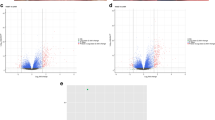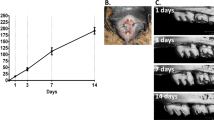Abstract
Corticision is a common technique to accelerate orthodontic tooth movement; however, not much is known about the underlying mechanisms. In this study, we investigated the mechanism of alveolar tissue remodeling after corticision in a rat model of tooth movement (TM) by analyzing the differential transcriptome. A total of 36 male rats were equally divided into TM and TM with corticision (TM+C) groups. Alveolar bone response was examined using micro-computed tomography (micro-CT). Osteoclasts and osteoblasts were quantified on tartrate-resistant acid phosphatase (TRAP) and Goldner’s trichrome staining. The transcriptomes of alveolus around the left maxillary first molar were determined on RNA sequencing (RNA-Seq), and the expression of selected differentially expressed genes (DEGs) validated on quantitative reverse-transcriptase polymerase chain reaction (qRT-PCR). Immunohistochemical examination of alveolar tissue was performed to examine the expressions of correlative proteins of the selected signaling pathway in the TM and TM+C groups. The ratio of bone volume to total volume (BV/TV), and the trabecular number (Tb.N) were significantly decreased, while the movement distance and the trabecular separation (Tb.Sp) was significantly increased in the TM+C group. However, no significant between-group difference in trabecular thickness (Tb.Th) was observed. On histomorphometric analysis, a significant increase in the number of osteoclasts and increased bone resorption was observed in the TM+C group. A total of 399 DEGs were identified on RNA-SEq. Eleven selected genes were confirmed on qRT-PCR, which included components of the Ras signaling pathway. Four proteins of the Ras signaling pathway showed a higher expression in the TM+C group. Our findings indicate that corticision may speed up orthodontic tooth movement by accelerating osteoclastogenesis mediated via the Ras signaling pathway.





Similar content being viewed by others
References
Ahearn IM, Haigis K, Bar-Sagi D, Philips MR (2011) Regulating the regulator: post-translational modification of RAS. Nat Rev Mol Cell Biol 13(1):39–51. doi:10.1038/nrm3255
Ai H, Xu QF, Lu HF, Mai ZH, An AQ, Liu GP (2008) Rapid tooth movement through distraction osteogenesis of the periodontal ligament in dogs. Chin Med J 121(5):455–462
Baloul SS, Gerstenfeld LC, Morgan EF, Carvalho RS, Van Dyke TE, Kantarci A (2011) Mechanism of action and morphologic changes in the alveolar bone in response to selective alveolar decorticationfacilitated tooth movement. Am J Orthod Dentofac Orthop 139(4 Suppl):S83–S101. doi:10.1016/j.ajodo.2010.09.026
Barabási AL, Oltvai ZN (2004) Network biology: understanding the cell’s functional organization. Nat Rev Genet 5(2):101–113. doi:10.1038/nrg1272
Barlow M, Kula K (2008) Factors influencing efficiency of sliding mechanics to close extraction space: a systematic review. Orthod Craniofac Res 11(2):65–73. doi:10.1111/j.1601-6343.2008.00421.x
Bos JL, Rehmann H, Wittinghofer A (2007) GEFs and GAPs: critical elements in the control of small G proteins. Cell 129(5):865–877. doi:10.1016/j.cell.2007.05.018
Bradley EW, Ruan MM, Vrable A, Oursler MJ (2008) Pathway crosstalk between Ras/Raf and PI3K in promotion of M-CSF-induced MEK/ERK-mediated osteoclast survival. J Cell Biochem 104:1439–1451. doi:10.1002/jcb.21719
Chang L, Karin M (2001) Mammalian MAP kinase signalling cascades. Nature 410:37–40. doi:10.1038/35068583
Chen W, Ma J, Zhu G, Jules J, Wu M, McConnell M, Tian F, Paulson C, Zhou X, Wang L et al (2014) Cbfβ deletion in mice recapitulates cleidocranial dysplasia and reveals multiple functions of Cbfβ required for skeletal development. Proc Natl Acad Sci USA 111(23):8482–8487. doi:10.1073/pnas.1310617111
Cohen G, Campbell PM, Rossouw PE, Buschang PH (2010) Effects of increased surgical trauma on rates of tooth movement and apical root resorption in foxhound dogs. Orthod Craniofac Res 13:179–190. doi:10.1111/j.1601-6343.2010.01494.x
Cui J, Li J, Wang W, Han X, Du J, Sun J, Feng W, Liu B, Liu H, Amizuka N et al (2016) The effect of calcitriol on high mobility group box 1 expression in periodontal ligament cells during orthodontic tooth movement in rats. J Mol Histol 47(2):221–228. doi:10.1007/s10735-016-9669-0
Dibart S, Sebaoun JD, Surmenian J (2009) Piezocision: a minimally invasive, periodontally accelerated orthodontic tooth movement procedure. Compend Contin Educ Dent 30(6):342
Fu HD, Wang BK, Wan ZQ, Lin H, Chang ML, Han GL (2016) Wnt5a mediated canonical Wnt signaling pathway activation in orthodontic tooth movement: possible role in the tension force-induced bone formation. J Mol Histol 47(5):455–466. doi:10.1007/s10735-016-9687-y
Goke J, Chan YS, Yan J, Vingron M, Ng HH (2013) Genome-wide kinase-chromatin interactions reveal the regulatory network of ERK signaling in human embryonic stem cells. Mol Cell 50(6):844–855. doi:10.1016/j.molcel.2013.04.030
Iino S, Sakoda S, Ito G, Nishimori T, Ikeda T, Miyawaki S (2007) Acceleration of orthodontic tooth movement by alveolar corticotomy in the dog. Am J Orthod Dentofac Orthop 131:448.e1-8. doi:10.1016/j.ajodo.2006.08.014
Iseri H, Kisnisci R, Bzizi N, Tüz H (2005) Rapid canine retraction and orthodontic treatment with dentoalveolar distraction osteogenesis. Am J Orthod Dentofac Orthop. 127(5):533–541. doi:10.1016/j.ajodo.2004.01.022 (quiz 625)
Karnoub AE, Weinberg RA (2008) Ras oncogenes:split personalities. Nat Rev Mol Cell Biol 9(7):517–531. doi:10.1038/nrm2438
Kim SJ, Moon SU, Kang SG, Park YG (2009a) Effects of low-level laser therapy after corticision on tooth movement and paradental remodeling. Lasers Surg Med 41(7):524–533. doi:10.1002/lsm.20792
Kim SJ, Park YG, Kang SG (2009b) Effects of corticision on paradental remodeling in orthodontic tooth movement. Angle Orthod 79(2):284–291. doi:10.2319/020308-60.1
Kisnisci RS, Iseri H, Tüz HH, Altug AT (2002) Dentoalveolar distraction osteogenesis for rapid orthodontic canine retraction. J Oral Maxillofac Surg 60(4):389–394
Lambert JM, Lambert QT, Reuther GW, Malliri A, Siderovski DP, Sondek J, Collard JG, Der CJ (2002) Tiam1 mediates Ras activation of Rac by a PI(3)K-independent mechanism. Nat Cell Biol 4:621–625. doi:10.1038/ncb833
Li J, Feng W, Liu B, Sun B, Han X, Du J, Sun J, Yimin, Cui J, Guo J et al (2015) Altered distribution of HMGB1 in the periodontal ligament of periostin-deficient mice subjected to Waldo’s orthodontic tooth movement. J Mol Histol 46(3):303–311. doi:10.1007/s10735-015-9619-2
Liou EJ, Huang CS (1998) Rapid canine retraction through distraction of the periodontal ligament. Am J Orthod Dentofac Orthop 114:372–382
Lv S, Li J, Feng W, Liu H, Du J, Sun J, Cui J, Sun B, Han X, Oda K et al (2015) Expression of HMGB1 in the periodontal tissue subjected to orthodontic force application by Waldo’s method in mice. J Mol Histol 46(1):107–114. doi:10.1007/s10735-014-9606-z
Mellis DJ, Itzstein C, Helfrich MH, Crockett JC (2011) The skeleton: a multi-functional complex organ: the role of key signalling pathways in osteoclast differentiation and in bone resorption. J Endocrinol 211(2):131–143. doi:10.1530/JOE-11-0212
Mor A, Philips MR (2006) Compartmentalized Ras/MAPK signaling. Annu Rev Immunol 24:771–800. doi:10.1146/annurev.immunol.24.021605.090723
Mostafa YA, Fayed MM, Mehanni S, ElBokle NN, Heider AM (2009) Comparison of corticotomy-facilitated vs standard tooth-movement techniques in dogs with miniscrews as anchor units. Am J Orthod Dentofac Orthop 136:570–577. doi:10.1016/j.ajodo.2007.10.052
Murphy KG, Wilcko MT, Wilcko WM, Ferguson DJ (2009) Periodontal accelerated osteogenic orthodontics: a description of the surgical technique. J Oral Maxillofac Surg 67(10):2160–2166. doi:10.1016/j.joms.2009.04.124
Murphy CA, Chandhoke T, Kalajzic Z, Flynn R, Utreja A, Wadhwa S, Nanda R, Uribe F (2014) Effect of corticision and different force magnitudes on orthodontic tooth movement in a rat model. Am J Orthod Dentofac Orthop 146(1):55–66. doi:10.1016/j.ajodo.2014.03.024
Peron AP, Johann AC, Papalexiou V, Tanaka OM, Guariza-Filho O, Ignácio SA, Camargo ES (2017) Tissue responses resulting from tooth movement surgically assisted by corticotomy and corticision in rats. Angle Orthod 87:118–124. doi:10.2319/102915-731.1
Prieto C, Risueño A, Fontanillo C, De las Rivas J (2008) Human gene coexpression landscape: confident network derived from tissue transcriptomic profiles. PLoS ONE 3:e3911. doi:10.1371/journal.pone.0003911
Ravasz E, Somera AL, Mongru DA, Oltvai ZN, Barabási AL (2002) Hierarchical organization of modularity in metabolic networks. Science 297(5586):1551–1555. doi:10.1126/science.1073374
Ren A, Lv T, Kang N, Zhao B, Chen Y, Bai D (2007) Rapid orthodontic tooth movement aided by alveolar surgery in beagles. Am J Orthod Dentofac Orthop 131:160.e1-10. doi:10.1016/j.ajodo.2006.05.029
Shin J, Jang H, Lin J, Lee SY (2014) PKCβ positively regulates RANKL-induced osteoclastogenesis by inactivating GSK-3β. Mol Cells 37(10):747–752. doi:10.14348/molcells.2014.0220
Stone JC (2011) Regulation and function of the RasGRP family of Ras activators in blood cells. Genes Cancer 2(3):320–334. doi:10.1177/1947601911408082
Sun J, Du J, Feng W, Lu B, Liu H, Guo J, Amizuka N, Li M (2016) Histological evidence that metformin reverses the adverse effects of diabetes on orthodontic tooth movement in rats. J Mol Histol. doi:10.1007/s10735-016-9707-y.
Taddei SR, Moura AP, Andrade I Jr, Garlet GP, Garlet TP, Teixeira MM, da Silva TA (2012) Experimental model of tooth movement in mice: a standardized protocol for studying bone remodeling under compression and tensile strains. J Biomech 45:2729–2735. doi:10.1016/j.jbiomech.2012.09.006
Takayanagi H, Kim S, Koga T, Nishina H, Isshiki M, Yoshida H, Saiura A, Isobe M, Yokochi T, Inoue J et al (2002) Induction and activation of the transcription factor NFATc1 (NFAT2) integrate RANKL signaling in terminal differentiation of osteoclasts. Dev Cell 3:889–901
Tsai CY, Yang TK, Hsieh HY, Yang LY (2016) Comparison of the effects of micro-osteoperforation and corticision on the rate of orthodontic tooth movement in rats. Angle Orthod 86(4):558–564. doi:10.2319/052015-343.1
Ulbrich SE, Groebner AE, Bauersachs S (2013) Transcriptional profiling to address molecular determinants of endometrial receptivity–lessons from studies in livestock species. Methods 59:108–115. doi:10.1016/j.ymeth.2012.10.013
Vigil D, Cherfils J, Rossman KL, Der CJ (2010) Ras superfamily GEFs and GAPs: validated and tractable targets for cancer therapy? Nat Rev Cancer 10(12):842–857. doi:10.1038/nrc2960
Wang L, Lee W, Lei DL, Liu YP, Yamashita DD, Yen SL (2009a) Tissue responses in corticotomy- and osteotomy-assisted tooth movements in rats: histology and immunostaining. Am J Orthod Dentofac Orthop 136:770.e1-11. doi:10.1016/j.ajodo.2009.05.015
Wang Z, Gerstein M, Snyder M (2009b) RNA-Seq: a revolutionary tool for transcriptomics. Nat Rev Genet 10(1):57–63. doi:10.1038/nrg2484
Weivoda MM, Oursler MJ (2014) The roles of small GTPases in osteoclast biology. Orthop Muscular Syst. doi:10.4172/2161-0533.1000161
Wilcko WM, Wilcko T, Bouquot JE, Ferguson DJ (2001) Rapid orthodontics with alveolar reshaping: two case reports of decrowding. Int J Periodontics Restorative Dent 21:9–19
Wilcko MT, Wilcko WM, Pulver JJ, Bissada NF, Bouquot JE (2009) Accelerated osteogenic orthodontics technique: a 1-stage surgically facilitated rapid orthodontic technique with alveolar augmentation. J Oral Maxillofac Surg 67(10):2149–2159. doi:10.1016/j.joms.2009.04.095
Yasuda T, Kurosaki T (2008) Regulation of Lymphocyte fate by Ras/ERK signals. Cell Cycle 7(23):3634–3640. doi:10.4161/cc.7.23.7103
Acknowledgements
This work was supported by the National Natural Science Foundation of China (81371179), Natural Science Foundation of Jiangsu Province (BK20150048), and Project Funded by the Priority Academic Program Development of Jiangsu Higher Education Institutions (2014-037).
Author information
Authors and Affiliations
Corresponding authors
Ethics declarations
Conflict of interest
The authors declare that they have no conflict of interest with regard to the content of this article.
Additional information
Qihui Gu and Shuyu Guo have contributed equally to this work.
Rights and permissions
About this article
Cite this article
Gu, Q., Guo, S., Wang, D. et al. Effect of corticision on orthodontic tooth movement in a rat model as assessed by RNA sequencing. J Mol Hist 48, 199–208 (2017). https://doi.org/10.1007/s10735-017-9718-3
Received:
Accepted:
Published:
Issue Date:
DOI: https://doi.org/10.1007/s10735-017-9718-3




